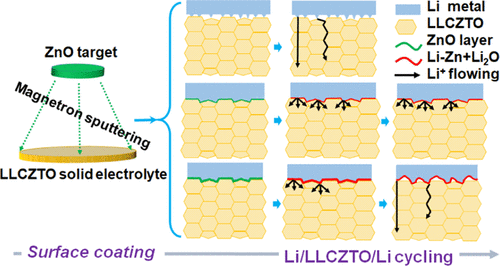
Scientists from Institute of Solid State Physics under Hefei Institutes of Physical Science reported the effect of ZnO as transition layer on the lithium dendrite and interfacial impedance between lithium and solid-state electrolyte.
All-solid-state batteries using metallic lithium as the anode are considered as one of the most promising lithium batteries with high safety and high energy density.
However, due to the poor wettability of lithium metal on the surface of the solid electrolyte, a large number of pores existing in the interface would seriously affect the transmission efficiency of lithium ions, resulting in high interface impedance and lithium dendrite growth.
By using ZnO as the interfacial membrane, the interface contact could be effectively improved, but the related influence mechanism is poorly understood.
For further exploration, researchers have sputtered ZnO layers with different thicknesses on the surface of the Ca/Ta co-doped Li6.55La2.95Ca0.05Zr1.5Ta0.5O12 (LLCZTO) electrolyte by magnetron sputter deposition.
They also assembled the cells with lithium metal as the counter electrodes. The composition, structure, and electrochemical performance of the cells were tested to investigate the influence of ZnO layer on the interface impedance and lithium ion transport (Figure 1).
In addition, based on SEM images of the cross-section (Figure 2), the researchers found that ZnO could react with lithium metal and the side reaction products would distort the coating layer due to volume expansion.
When the ZnO layer was only about 200 nm, the swelling effect was not obvious, and the lithium metal had a good close contact with the electrolyte layer (Figure 2a); but an excessively thick ZnO layer would form a wrinkle due to volume expansion in the interface.
The periodic pore structures would significantly reduce the effective contact area in the interface (Figure 2b), which was one of the main reasons for the increase of the interface impedance.
Meantime, the instability of the interface would also lead to the local deposition of lithium ions to form dendrites, the short-circuit and a reduced cycle life.
This work provides a theoretical and experimental basis for the improvement of the interfacial properties and safety of all-solid-state batteries. And the study is sponsored by the National Key Research and Development Program of China, the National Natural Science Foundation of China, the Anhui Provincial Natural Science Foundation, and the Hefei Center of Materials Science and Technology.

Schematic illustration of the preparation and the evolution of Li/LLCZTO interfacial contact and Li metal growth through LLCZTO with different ZnO thickness during Li plating/stripping process. (Image by ZHANG Linchao)

SEM and EDS images of the cross-section of the cells with (a) 200 nm and (b) 600 nm ZnO layer as interfacial membrane. (Image by ZHANG Linchao)

86-10-68597521 (day)
86-10-68597289 (night)

86-10-68511095 (day)
86-10-68512458 (night)

cas_en@cas.cn

52 Sanlihe Rd., Xicheng District,
Beijing, China (100864)

